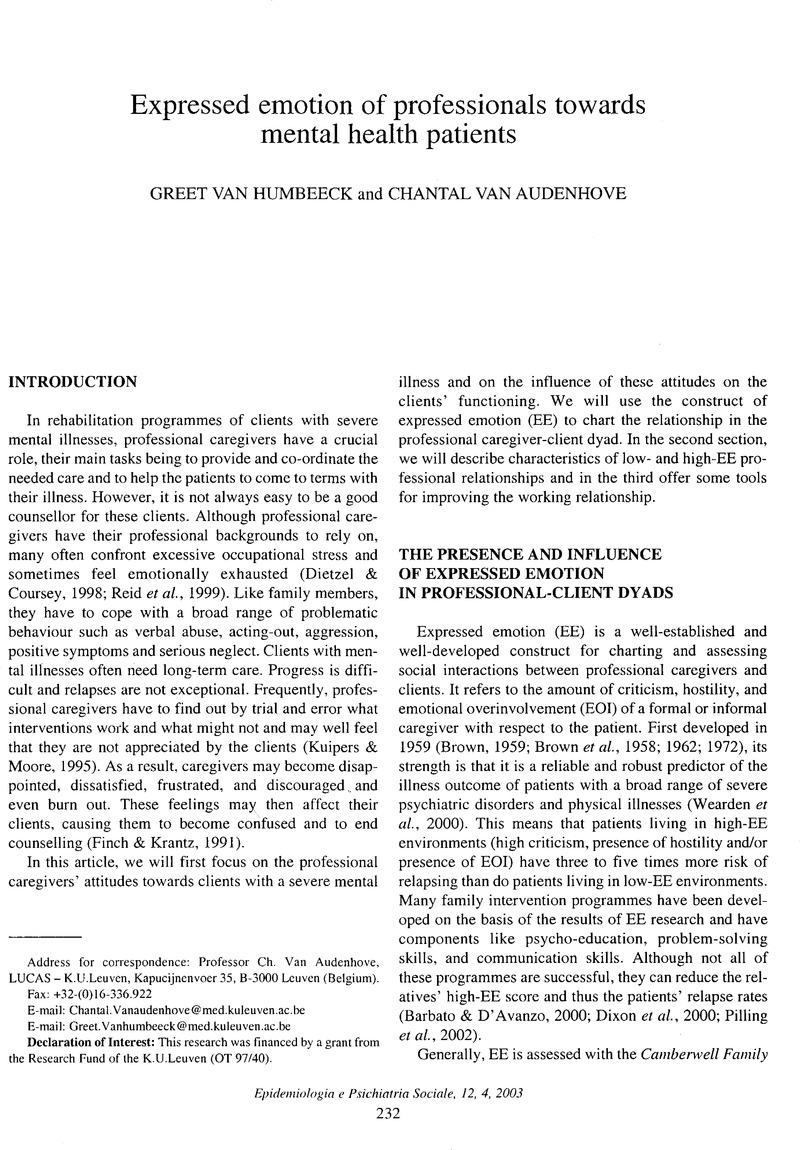Crossref Citations
This article has been cited by the following publications. This list is generated based on data provided by Crossref.
Watts, Malcolm
2007.
High expressed emotion, severe mental illness and substance use disorder.
British Journal of Nursing,
Vol. 16,
Issue. 20,
p.
1259.
DENNIS, A. M.
and
LEACH, C.
2007.
Expressed emotion and burnout: the experience of staff caring for men with learning disability and psychosis in a medium secure setting.
Journal of Psychiatric and Mental Health Nursing,
Vol. 14,
Issue. 3,
p.
267.
Watts, Malcolm
2007.
High expressed emotion: precipitating relapse in substance misuse disorders.
British Journal of Nursing,
Vol. 16,
Issue. 22,
p.
1396.
Watts, Malcolm
2009.
Substance abuse: how the healthcare assistant can help.
British Journal of Healthcare Assistants,
Vol. 3,
Issue. 11,
p.
552.
Solomon, Phyllis
Alexander, Leslie
and
Uhl, Stacey
2010.
The relationship of case managers’ expressed emotion to clients’ outcomes.
Social Psychiatry and Psychiatric Epidemiology,
Vol. 45,
Issue. 2,
p.
165.
Moore, Estelle
Andargachew, Sara
and
Taylor, Pamela J
2011.
Working with women prisoners who seriously harm themselves: Ratings of staff expressed emotion (EE).
Criminal Behaviour and Mental Health,
Vol. 21,
Issue. 1,
p.
63.
van Oorsouw, Wietske M.W.J.
Embregts, Petri J.C.M.
and
Sohier, Jody
2011.
Verbal and nonverbal emotional behaviour of staff: A first attempt in the development of an observation instrument.
Research in Developmental Disabilities,
Vol. 32,
Issue. 6,
p.
2408.
Cechnicki, Andrzej
Bielańska, Anna
Hanuszkiewicz, Igor
and
Daren, Artur
2013.
The predictive validity of Expressed Emotions (EE) in schizophrenia. A 20-year prospective study.
Journal of Psychiatric Research,
Vol. 47,
Issue. 2,
p.
208.
Walker, T.
Edge, D.
Shaw, J.
Wilson, H.
McNair, L.
Mitchell, H.
Gutridge, K.
Senior, J.
Sutton, M.
Meacock, R.
and
Abel, K.
2017.
Contemporary women's secure psychiatric services in the United Kingdom: A qualitative analysis of staff views.
Journal of Psychiatric and Mental Health Nursing,
Vol. 24,
Issue. 9-10,
p.
660.
de Almeida Mello, Johanna
Luo, Hao
Hirdes, Alice
Heikkilä, Jyrki
Umubyeyi, Benoite
Gishoma, Darius
Saari, Margaret
Hirdes, John P.
and
Van Audenhove, Chantal
2021.
An International Pilot Study of Self-Reported Quality of Life in Outpatient and Inpatient Mental Health Settings.
Frontiers in Psychiatry,
Vol. 12,
Issue. ,
Lee-Tauler, Su Yeon
LaCroix, Jessica M.
Carter, Sarah P.
Perera, Kanchana U.
Goldston, David B.
Stivers, Max
Soumoff, Alyssa
Sapyta, Jeffrey J.
Weller, Bridget E.
Inscoe, Adrienne Banny
Weaver, Jennifer J.
and
Ghahramanlou-Holloway, Marjan
2022.
Perceived changes in social interactions following military psychiatric hospitalization for a suicidal crisis.
Military Psychology,
Vol. 34,
Issue. 3,
p.
296.



